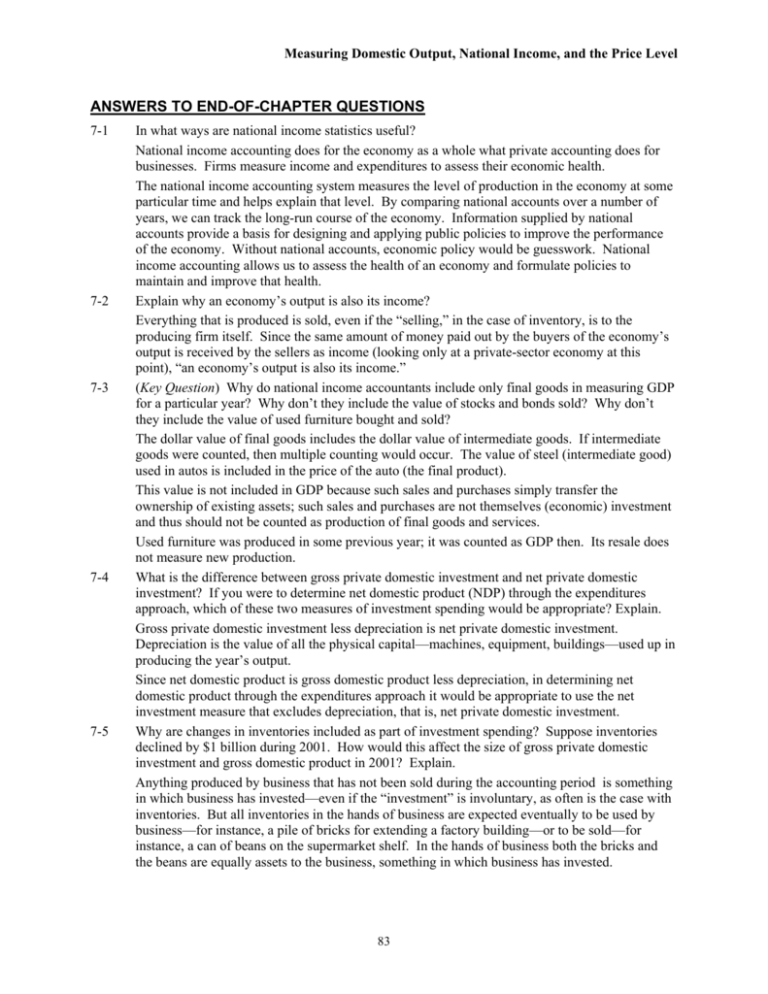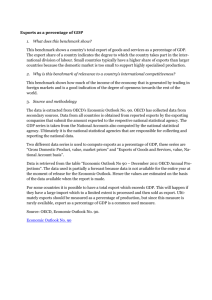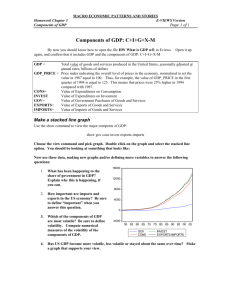ANSWERS TO END-OF-CHAPTER QUESTIONS
advertisement

Measuring Domestic Output, National Income, and the Price Level ANSWERS TO END-OF-CHAPTER QUESTIONS 7-1 7-2 7-3 7-4 7-5 In what ways are national income statistics useful? National income accounting does for the economy as a whole what private accounting does for businesses. Firms measure income and expenditures to assess their economic health. The national income accounting system measures the level of production in the economy at some particular time and helps explain that level. By comparing national accounts over a number of years, we can track the long-run course of the economy. Information supplied by national accounts provide a basis for designing and applying public policies to improve the performance of the economy. Without national accounts, economic policy would be guesswork. National income accounting allows us to assess the health of an economy and formulate policies to maintain and improve that health. Explain why an economy’s output is also its income? Everything that is produced is sold, even if the “selling,” in the case of inventory, is to the producing firm itself. Since the same amount of money paid out by the buyers of the economy’s output is received by the sellers as income (looking only at a private-sector economy at this point), “an economy’s output is also its income.” (Key Question) Why do national income accountants include only final goods in measuring GDP for a particular year? Why don’t they include the value of stocks and bonds sold? Why don’t they include the value of used furniture bought and sold? The dollar value of final goods includes the dollar value of intermediate goods. If intermediate goods were counted, then multiple counting would occur. The value of steel (intermediate good) used in autos is included in the price of the auto (the final product). This value is not included in GDP because such sales and purchases simply transfer the ownership of existing assets; such sales and purchases are not themselves (economic) investment and thus should not be counted as production of final goods and services. Used furniture was produced in some previous year; it was counted as GDP then. Its resale does not measure new production. What is the difference between gross private domestic investment and net private domestic investment? If you were to determine net domestic product (NDP) through the expenditures approach, which of these two measures of investment spending would be appropriate? Explain. Gross private domestic investment less depreciation is net private domestic investment. Depreciation is the value of all the physical capital—machines, equipment, buildings—used up in producing the year’s output. Since net domestic product is gross domestic product less depreciation, in determining net domestic product through the expenditures approach it would be appropriate to use the net investment measure that excludes depreciation, that is, net private domestic investment. Why are changes in inventories included as part of investment spending? Suppose inventories declined by $1 billion during 2001. How would this affect the size of gross private domestic investment and gross domestic product in 2001? Explain. Anything produced by business that has not been sold during the accounting period is something in which business has invested—even if the “investment” is involuntary, as often is the case with inventories. But all inventories in the hands of business are expected eventually to be used by business—for instance, a pile of bricks for extending a factory building—or to be sold—for instance, a can of beans on the supermarket shelf. In the hands of business both the bricks and the beans are equally assets to the business, something in which business has invested. 83 Measuring Domestic Output, National Income, and the Price Level 7-6 7-7 7-8 If inventories declined by $1 billion in 2001, $1 billion would be subtracted from both gross private domestic investment and gross domestic product. A decline in inventories indicates that goods produced in a previous year have been used up in this year’s production. If $1 billion is not subtracted as stated, then $1 billion of goods produced in a previous year would be counted as having been produced in 2001, leading to an overstatement of 2001’s production. Use the concepts of gross and net investment to distinguish between an economy that has a rising stock of capital and one that has a falling stock of capital. “In 1933 net private domestic investment was minus $6 billion. This means in that particular year the economy produced no capital goods at all.” Do you agree? Explain: “Though net investment can be positive, negative, or zero, it is quite impossible for gross investment to be less than zero.” When gross investment exceeds depreciation, net investment is positive and production capacity expands; the economy ends the year with more physical capital than it started with. When gross investment equals depreciation, net investment is zero and production capacity is said to be static; the economy ends the year with the same amount of physical capital. When depreciation exceeds gross investment, net investment is negative and production capacity declines; the economy ends the year with less physical capital. The first statement in wrong. Just because net investment was a minus $6 billion in 1993 does not mean the economy produced no new capital goods in that year. It simply means depreciation exceeded gross investment by $6 billion. So the economy ended the year with $6 billion less capital. The second statement is correct. If only one $20 spade is bought by a construction firm in the entire economy in a year and no other physical capital is bought, then gross investment is $20—a positive amount. This is true even if net investment is highly negative because depreciation is well above $20. If not even this $20 spade has been bought, then gross investment would have been zero. But gross investment can never be less than zero. Define net exports. Explain how the United States’ exports and imports each affect domestic production. Suppose foreigners spend $7 billion on American exports in a given year and Americans spend $5 billion on imports from abroad in the same year. What is the amount of America’s net exports? Explain how net exports might be a negative amount. Net exports are a country’s exports of goods and services less its imports of goods and services. The United States’ exports are as much a part of the nation’s production as are the expenditures of its own consumers on goods and services made in the United States. Therefore, the United States’ exports must be counted as part of GDP. On the other hand, imports, being produced in foreign countries, are part of those countries’ GDPs. When Americans buy imports, these expenditures must be subtracted from the United States’ GDP, for these expenditures are not made on the United States’ production. If American exports are $7 billion and imports are $5 billion, then American net exports are +$2 billion. If the figures are reversed, so that Americans export $5 billion and import $7 billion, then net exports are -$2 billion—a negative amount. For this to come about, Americans must either decrease their holdings of foreign currencies by $2 billion, or borrow $2 billion from foreigners— or do a bit of both. (Another option is to sell back to foreigners some of the previous American investments abroad.) (Key Question) Below is a list of domestic output and national income figures for a given year. All figures are in billions. The questions that follow ask you to determine the major national income measures by both the expenditure and income methods. The results you obtain with the different methods should be the same. 84 Measuring Domestic Output, National Income, and the Price Level $245 4 12 14 27 20 13 33 11 16 223 18 21 26 19 56 72 33 20 Personal consumption expenditures Net foreign factor income earned Transfer payments Rents Consumption of fixed capital (depreciation) Social security contributions Interest Proprietors’ income Net exports Dividends Compensation of employees Indirect business taxes Undistributed corporate profits Personal taxes Corporate income taxes Corporate profits Government purchases Net private domestic investment Personal saving 7-9 a. Using the above data, determine GDP and NDP by both the expenditure and income methods. b. Now determine NI: first, by making the required additions and subtractions from GDP; and second, by adding up the types of income which comprise NI. c. Adjust NI from (b) as required to obtain PI. d. Adjust PI from part c as required to obtain DI. (a) GDP = $388, NDP = $362; (b) NI = $399; (c) PI = $291; (d) DI = $265. Using the following national income accounting data, compute (a) GDP, (b) NDP, (c) NI. All figures are in billions. Compensation of employees U.S. exports of goods and services Consumption of fixed capital Government purchases of goods and services Indirect business taxes Net private domestic investment Transfer payments U.S. imports of goods and services Personal taxes Net foreign factor income earned in U.S. Personal consumption expenditures 85 $194.2 17.8 11.8 59.4 14.4 52.1 13.9 16.5 40.5 2.2 219.1 Measuring Domestic Output, National Income, and the Price Level 7-10 7-11 (a) Personal consumption expenditures (C) Government purchases (G) Gross private domestic investment (Ig) (52.1 + 11.8) Net exports (Xn) (17.8 - 16.5) Gross domestic product (GDP) $219.1 59.4 63.9 (b) Consumption of fixed capital Net domestic product (NDP) -11.8 $331.9 1.3 $343.7 (c) Net foreign factor income earned in U.S. -2.2 Indirect business taxes -14.4 National income (NI) $315.3 Why do national income accountants compare the market value of the total outputs in various years rather than actual physical volumes of production? What problem is posed by any comparison over time of the market values of various total outputs? How is this problem resolved? If it is impossible to summarize oranges and apples as one statistic, as the saying goes, it is surely even more impossible to add oranges and, say, computers. If the production of oranges increases by 100 percent and that of computers by 10 percent, it does not make any sense to add the 100 percent to the 10 percent, then divide by 2 to get the average and say total production has increased by 55 percent. Since oranges and computers have different values, the quantities of each commodity are multiplied by their values or prices. Adding together all the results of the price times quantity figures leads to the aggregate figure showing the total value of all the final goods and services produced in the economy. Thus, to return to oranges and computers, if the value of orange production increases by 100 percent from $100 million to $200 million, while that of computers increases 10 percent from $2 billion to $2.2 billion, we can see that total production has increased from $2.1 billion (= $100 million + $2 billion) to $2.4 billion (= $200 million + $2.2 billion). This is an increase of 14.29 percent [= ($2.4 billion - $2.1 billion)/$2.1 billion)]—and not the 55 percent incorrectly derived earlier. Comparing market values over time has the disadvantage that prices change. If the market value in year 2 is 10 percent greater than in year 1, we cannot say the economy’s production has increased 10 percent. It depends on what has been happening to prices; on whether the economy has been experiencing inflation or deflation. To resolve this problem, statisticians deflate (in the case of inflation) or inflate (in the case of deflation) the value figures for the total output so that only “real” changes in production are recorded. To do this, each item is assigned a “weight” corresponding to its relative importance in the economy. Housing, for example, is given a high weight because of its importance in the average budget. A book of matches would be given a very low weight. Thus, the price of housing increasing by 5 percent has a much greater effect on the price index used to compare prices from one year to the next, than would the price of a book of matches increasing by 100 percent. (Key Question) Suppose that in 1984 the total output in a single-good economy was 7,000 buckets of chicken. Also suppose that in 1984 each bucket of chicken was priced at $10. Finally, assume that in 1992 the price per bucket of chicken was $16 and that 22,000 buckets were purchased. Determine the GDP price index for 1984, using 1992 as the base year. By what percentage did 86 Measuring Domestic Output, National Income, and the Price Level the price level, as measured by this index, rise between 1984 and 1992? Use the two methods listed in Table 7-6 to determine real GDP for 1984 and 1992. X/100 = $10/$16 = .625 or 62.5 when put in percentage or index form (.625 x 100) 100 − 62.5 16 − 10 6 = .60 or 60% (Easily calculated = = .6 = 60% ) 62.5 10 10 7-12 7-13 Method 1: 1992 = (22,000 x $16) ÷ 1.0 = $352,000 1984 = ($7,000 x $10) ÷ .625 = $112,000 Method 2: 1992 = 22,000 x $16 = $352,000 1984 = 7,000 x $16 = $112,000 (Key Question) The following table shows nominal GDP and an appropriate price index for a group of selected years. Compute real GDP. Indicate in each calculation whether you are inflating or deflating the nominal GDP data. Year Normal GDP, Billions Price index (1996 – 100) Real GDP billions 1960 1968 1978 1988 1998 $527.4 911.5 2295.9 4742.5 8790.2 22.19 26.29 48.22 80.22 103.22 $ ______ $ ______ $ ______ $ ______ $ ______ Values for real GDP, top to bottom of the column: $2,376.7 (inflating); $3,467.1 (inflating); $4,761.3 (inflating); $5,911.9 (inflating); $8,516 (deflating). Which of the following are actually included in this year’s GDP? Explain your answer in each case. a. Interest on an AT&T bond b. Social security payments received by a retired factory worker c. The services of a painter in painting the family home d. The income of a dentist e. The money received by Smith when she sells her economics textbook to a book buyer f. The monthly allowance a college student receives from home g. Rent received on a two-bedroom apartment h. The money received by Mac when he resells his current-year model Plymouth Prowler to Stan i. Interest received on corporate bonds j. A 2-hour decline in the length of the workweek k. The purchase of an AT&T bond l. A $2 billion increase in business inventories m. The purchase of 100 shares of GM common stock n. The purchase of an insurance policy 87 Measuring Domestic Output, National Income, and the Price Level 7-13 (a) Included. Income received by the bondholder for the services derived by the corporation for the loan of money. (b) Excluded. A transfer payment from taxpayers for which no service is rendered (in this year). (c) Excluded. Not a market transaction. If any payment is made, it will be within the family. (d) Included. Payment for a final service. You cannot pass on a tooth extraction! (e) Excluded. Secondhand sales are not counted; the textbook is counted only when sold for the first time. (f) Excluded. A private transfer payment; simply a transfer of income from one private individual to another for which no transaction in the market occurs. (g) Included. Payment for the final service of housing. (h) Excluded. The production of the car had already been counted at the time of the initial sale. (i) Included. The income received by the bondholders is paid by the corporations for the current use of the “money capital” (the loan). (j) Excluded. The effect of the decline will be counted, but the change in the work week itself is not the production of a final good or service or a payment for work done. (k) Excluded. A non-investment transaction; it is merely the transfer of ownership of financial assets. (If AT&T uses the money from the sale of a new bond to carry out an investment in real physical assets, that will be counted.) (l) Included. The increase in inventories could only occur as a result of increased production. (m) Excluded. Merely the transfer of ownership of existing financial assets. (n) Included. Insurance is a final service. If bought by a household, it will be shown as consumption; if bought by a business, as investment—as a cost added to its real investment in physical capital. (Last Word) What government agency compiles the U.S. GDP accounts? In what U.S. Department is it located? Of the several sources of information, name one source for each of the four components of GDP: consumption, investment, government purchases and net exports. The Bureau of Economic Analysis (BEA) in the Department of Commerce compiles GDP statistics. The Census Bureau provides survey data for consumption, investment, and government purchases. Consumption figures also come from industry trade sources as does some investment data. The U.S. Office of Personnel Management also provides data on government spending on services. Net export figures come from the U.S. Customs Service and BEA surveys on service exports and imports. 88









